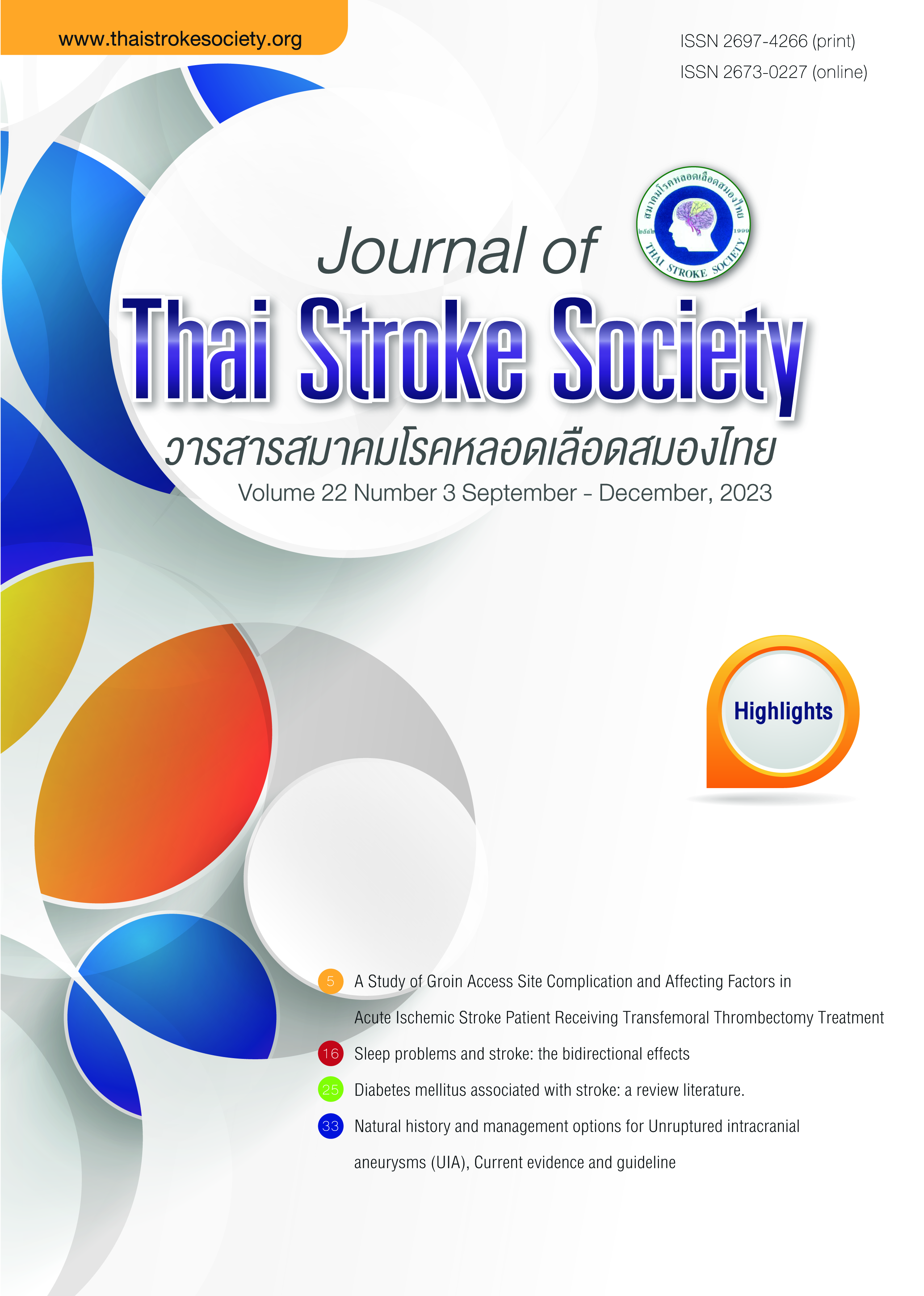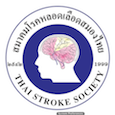Sleep problems and stroke: the bidirectional effects
Keywords:
Sleep, Sleep Disorders, stroke network, Sleep ApneaAbstract
There is the bidirectional association between stroke and sleep. Some sleep disorders may act as a risk factor of stroke, especially sleep apnea that has a strong relationship with stroke and other cardiovascular diseases. Sleep disorders increase cardiovascular events by increasing sympathetic tone, vascular inflammation, and thrombosis. Conversely, stroke may cause sleep disorders and affect breathing patterns during sleep. Meanwhile post-stroke sleep disorders also impact stroke outcomes and quality of life. Treatment to reduce sleep problems may be important in both primary and secondary stroke prevention and stroke outcomes.
References
Karen L, et al. Guidelines for the Prevention of Stroke in Patients With Stroke or Transient Ischemic Attack. A Guideline for Healthcare Professionals From the American Heart Association/ American Stroke Association Stroke. 2011;42:227-76.
Bonita R, Mendis S, Truelsen T, Bogousslavsky J, Toole J, Yatsu F. The global stroke initiative. Lancet Neurol 2004; 3: 391-3.
Feigin VL, Forouzanfar MH, Krishnamurthi R, et al. Global and regional burden of stroke during 1990-2010: findings from the Global Burden of Disease Study 2010. Lancet 2014;383:245-54.
Bundhamcharoen K, Odton P, Phulkerd S, Tangcharoensathien V. Burden of disease in Thailand: changes in health gap between 1999 and 2004. BMC Public Health. 2011 Jan 26;11:53.
Poungvarin N. Burden of stroke in Thailand. Int J Stroke 2007; 2: 127-8.
Duss SB, Seiler A, Schmidt MH, et al. The role of sleep in recovery following ischemic stroke: a review of human and animal data. Neurobiol Sleep Circadian Rhythms 2016;2:94-105.
Marshall J. Diurnal variation in occurrence of strokes. Stroke 1977;8:230-1.
Argentino C, Toni D, Rasura M, et al. Circadian variation in the frequency of ischemic stroke. Stroke 1990;21:387-9.
Marler JR, Price TR, Clark GL, et al. Morning increase in onset of ischemic stroke. Stroke 1989;20:473-6.
Wroe SJ, Sandercock P, Bamford J, et al. Diurnal variation in incidence of stroke: Oxfordshire community stroke project. BMJ 1992;304:155-7.
Fink JN, Kumar S, Horkan C, et al. The stroke patient who woke up: clinical and radiological features, including diffusion and perfusion MRI. Stroke 2002;33:988-93.
Lago A, Geffner D, Tembl J, et al. Circadian variation in acute ischemic stroke: a hospital-based study. Stroke 1998;29:1873-5.
Somers VK, Dyken ME, Mark AL, et al. Sympathetic nerve activity during sleep in normal subjects. N Engl J Med 1993;328:303-7.
Mancia G. Autonomic modulation of the cardiovascular system during sleep. N Engl J Med 1993;328:347-9.
Okada H, Iwase S, Mano T, et al. Changes in muscle sympathetic nerve activity during sleep in humans. Neurology 1991;41:1961-6.
Catcheside PG, Chiong SC, Orr RS, et al. Acute cardiovascular responses to arousal from non-REM sleep during normoxia and hypoxia. Sleep 2001;24:895-902.
Portaluppi F, Bagni B, degli Uberti E, et al. Circadian rhythms of atrial natriuretic peptide, renin, aldosterone, cortisol, blood pressure and heart rate in normal and hypertensive subjects. J Hypertens 1990;8:85-95.
Strawn WB, Ferrario CM. Mechanisms linking angiotensin II and atherogenesis. Curr Opin Lipidol 2002;13:505-12.
Elliott WJ. Circadian variation in the timing of stroke onset: a meta-analysis. Stroke 1998;29:992-6.
Birkbak, J., A.J. Clark, and N.H. Rod, The effect of sleep disordered breathing on the outcome of stroke and transient ischemic attack: a systematic review. J Clin Sleep Med, 2014. 10(1): p. 103-8.
Tofler GH, Brezinski D, Schafer AI, et al. Concurrent morning increase in platelet aggregability and the risk of myocardial infarction and sudden cardiac death. N Engl J Med 1987;316:1514-8.
Brezinski DA, Tofler GH, Muller JE, et al. Morning increase in platelet aggregability. Association with assumption of the upright posture. Circulation 1988;78:35-40.
Ehrly AM, Jung G. Circadian rhythm of human blood viscosity. Biorheology 1973;10:577-83.
Hepburn M, Bollu PC, French B, Sahota P (2018). Sleep Medicine: Stroke and Sleep. Mo Med, 115:527-532.
Winkelman, J.W.; Shahar, E.; Sharief, I.; Gottlieb, D.J. Association of restless legs syndrome and cardiovascular disease in the Sleep Heart Health Study. Neurology 2008, 70, 35-42.
Wong, J. C. et al. Risk factors for probable REM sleep behavior disorder. Neurology 86, 1306-1312 (2016).
Postuma RB, Montplaisir JY, Pelletier A, et al. Environmental risk factors for REM sleep behavior disorder: a multicenter case-control study. Neurology 2012;79:428-434.
Ma, C. et al. Probable REM sleep behavior disorder and risk of stroke. Neurology 88, 1849-1855 (2017).
Eguchi K, Hoshide S, Ishikawa S, et al. Short sleep duration is an independent predictor of stroke events in elderly hypertensive patients. J Am Soc Hypertens 2010;4:255-62.
von Ruesten A, Weikert C, Fietze I, et al. Association of sleep duration with chronic diseases in the European Prospective Investigation into Cancer and Nutrition (EPIC)-Potsdam study. PLoS One 2012;7:e30972.
He Q, Sun H, Wu X, et al. Sleep duration and risk of stroke: a dose-response meta analysis of prospective cohort studies. Sleep Med 2017;32:66-74.
Yin J, Jin X, Shan Z, et al. Relationship of sleep duration with all-cause mortality and cardiovascular events: a systematic review and dose-response metaanalysis of prospective cohort studies. J Am Heart Assoc 2017;6:e005947.
Svensson T, Saito E, Svensson AK, Melander O, Orho-Melander M, Mimura M, Rahman S, Sawada N, Koh WP, Shu XO, Tsuji I, Kanemura S, Park SK, Nagata C, Tsugane S, Cai H, Yuan JM, Matsuyama S, Sugawara Y, Wada K, Yoo KY, Chia KS, Boffetta P, Ahsan H, Zheng W, Kang D, Potter JD, Inoue M. Association of Sleep Duration With All- and Major-Cause Mortality Among Adults in Japan, China, Singapore, and Korea. JAMA Netw Open. 2021 Sep 1;4(9):e2122837.
Leng Y, Cappuccio FP, Wainwright NW, et al. Sleep duration and risk of fatal and nonfatal stroke: a prospective study and meta-analysis. Neurology 2015;84:1072-9.
Yan B, Li J, Li R, et al. Association of daytime napping with incident cardiovascular disease in a community-based population. Sleep Med 2019;57:128-34.
Gandhi, K.D.; Mansukhani, M.P.; Silber, M.H.; Kolla, B.P. Excessive Daytime Sleepiness: A Clinical Review. Mayo Clin. Proc. 2021, 96, 1288–1301.
Alexiev P, Brill A, Ott S, et al. Sleep-disordered breathing and stroke: chicken or egg? J Thorac Dis 2018;10:S4244e52.
Johnson KG, Johnson DC. Frequency of sleep apnea in stroke and TIA patients: a meta-analysis. J Clin Sleep Med 2010;6:131-7.
Quan, S.F., et al., The Sleep Heart Health Study: design, rationale, and methods. Sleep, 1997. 20(12): p. 1077-85.
Redline S, Yenokyan G, Gottlieb DJ, et al. Obstructive sleep apnea-hypopnea and incident stroke: the sleep heart health study. Am J Respir Crit Care Med 2010;182:269-77.
Peppard PE, Young T, Palta M, et al. Prospective study of the association between sleep-disordered breathing and hypertension. N Engl J Med 2000;342:1378-84.
Wolf J, Hering D, Narkiewicz K. Non-dipping pattern of hypertension and obstructive sleep apnea syndrome. Hypertens Res. 2010;33:867-871.
Fodor, D.M., I. Babiciu, and L. Perju-Dumbrava, Circadian Variation of Stroke Onset: A Hospital-Based Study. Clujul Medical, 2014. 87(4): p. 242-249.
Terzoudi A, Vorvolakos T, Heliopoulos I, et al. Sleep architecture in stroke and relation to outcome. Eur Neurol 2009;61:16-22.
Hermann DM, Siccoli M, Brugger P, et al. Evolution of neurological, neuropsychological and sleep-wake disturbances after paramedian thalamic stroke. Stroke 2008;39:62-8.
Reynolds TQ, Roy A. Isolated cataplexy and REM sleep behavior disorder after pontine stroke. J Clin Sleep Med 2011;7:211-3.
Ryan CM, Bayley M, Green R, Murray BJ, Bradley TD. Influence of continuous positive airway pressure on outcomes of rehabilitation in stroke patients with obstructive sleep apnea. Stroke. 2011;42:1062-1067.
Khot SP, Morgenstern LB (2019) Sleep and stroke. Stroke 50, 1612-1617.
Pérez-Carbonell, L., and Bashir, S. (2020). Narrative review of sleep and stroke. J. Thorac. Dis. 12(Suppl. 2), S176-S190.
Parra O, Arboix A, Bechich S, et al. Time course of sleep-related breathing disorders in first-ever stroke or transient ischemic attack. Am J Respir Crit Care Med 2000;161:375-80.
American Psychiatric Association, Diagnostic and Statistical Manual of Mental Disorders, American Psychiatric Publishing, Arlington, VA, USA, 5th edition, 2013.
Riemann D, Baglioni C, Bassetti C, et al. European guideline for the diagnosis and treatment of insomnia. J Sleep Res 2017;26:675-700.
Baylan S, Griffiths S, Grant N, et al. Incidence and prevalence of post-stroke insomnia: a systematic review and meta-analysis. Sleep Med Rev 2020;49:101222.
American Academy of Sleep Medicine. International Classification of Sleep Disorders. 3rd ed. Darien, IL: Author; 2014.
Šiarnik P, Klobučníková K, Šurda P, et al. Excessive daytime sleepiness in acute ischemic stroke: association with restless legs syndrome, diabetes mellitus, obesity, and sleep-disordered breathing. J Clin Sleep Med 2018;14:95-100.
Ferre A, Ribo´ M, Rodrı´guez-Luna D, et al. Strokes and their relationship with sleep and sleep disorders. Neurologia 2013;28(2):103–18.
Ding Q, Whittemore R, Redeker N. Excessive daytime sleepiness in stroke survivors: an integrative review. Biol Res Nurs 2016;18:420-31.
Šiarnik P, Klobučníková K, Šurda P, et al. Excessive daytime sleepiness in acute ischemic stroke: association with restless legs syndrome, diabetes mellitus, obesity, and sleep-disordered breathing. J Clin Sleep Med 2018;14:95-100.
Arzt, M., et al., Association of sleep-disordered breathing and the occurrence of stroke. Am J Respir Crit Care Med, 2005. 172(11): p. 1447-51.
Li Pi Shan RS, Ashworth NL (2004). Comparison of lorazepam and zopiclone for insomnia in patients with stroke and brain injury: a randomized, crossover, double-blinded trial. Am J Phys Med Rehabil, 83:421-427.
Khan SU, Duran CA, Rahman H, Lekkala M, Saleem MA, Kaluski E. A meta-analysis of continuous positive airway pressure therapy in prevention of cardiovascular events in patients with obstructive sleep apnoea. Eur Heart J. 2018;39:2291–2297.
Tsivgoulis G, Alexandrov AV, Katsanos AH, Barlinn K, Mikulik R, Lambadiari V, et al. Noninvasive ventilatory correction in patients with acute ischemic stroke: a systematic review and meta-analysis. Stroke. 2017;48:2285–2288.
Khot S, Barnett H, Davis A, et al. Intensive continuous positive airway pressure adherence program during stroke rehabilitation. Stroke. 2019(50):00-00.
Duss SB, Brill AK, Bargiotas P, Facchin L, Alexiev F, Manconi M, et al. (2018). Sleep-Wake Disorders in Stroke-Increased Stroke Risk and Deteriorated Recovery? An Evaluation on the Necessity for Prevention and Treatment. Curr Neurol Neurosci Rep, 18:72.
Nguyen S, Wong D, McKay A, Rajaratnam SMW, Spitz G, Williams G, et al. (2019). Cognitive behavioural therapy for post-stroke fatigue and sleep disturbance: a pilot randomised controlled trial with blind assessment. Neuropsychol Rehabil, 29:723-738.
Palomaki H, Berg A, Meririnne E, Kaste M, Lonnqvist R, Lehtihalmes M, et al. (2003). Complaints of poststroke insomnia and its treatment with mianserin. Cerebrovasc Dis, 15:56-62.
Kim JS, Lee EJ, Chang DI, Park JH, Ahn SH, Cha JK, et al. (2017). Efficacy of early administration of escitalopram on depressive and emotional symptoms and neurological dysfunction after stroke: a multicentre, double-blind, randomised, placebo-controlled study. Lancet Psychiatry, 4:33-41.
Hermann DM, Bassetti CL (2016). Role of sleep-disordered breathing and sleep-wake disturbances for stroke and stroke recovery. Neurology, 87:1407-1416.
Hiu T, Farzampour Z, Paz JT, Wang EH, Badgely C, Olson A, et al. (2016). Enhanced phasic GABA inhibition during the repair phase of stroke: a novel therapeutic target. Brain, 139:468-480.
Oh MK, Yoon KJ, Lee YT, Chae SW, Choi HY, Shin HS, et al. (2018). Effect of zolpidem on functional recovery in a rat model of ischemic stroke. J Int Med Res, 46:249-257.
Cai H., Wang X.P., Yang G.Y. Sleep Disorders in Stroke: An Update on Management. Aging Dis. 2021;12:570-585.
Bassetti C, Mathis J, Gugger M, Lovblad KO, Hess CW (1996). Hypersomnia following paramedian thalamic stroke: a report of 12 patients. Ann Neurol, 39:471-480.
Hermann DM, Bassetti CL (2009). Sleep-related breathing and sleep-wake disturbances in ischemic stroke. Neurology, 73:1313-1322.
Hermann DM, Bassetti CL (2016). Role of sleep-disordered breathing and sleep-wake disturbances for stroke and stroke recovery. Neurology, 87:1407-1416.
Lee SJ, Kim JS, Song IU, An JY, Kim YI, Lee KS (2009). Poststroke restless legs syndrome and lesion location: anatomical considerations. Mov Disord, 24:77-84.
Bassetti CLA, Randerath W, Vignatelli L, et al. EAN/ERS/ESO/ESRS statement on the impact of sleep disorders on risk and outcome of stroke. Eur J Neurol 2020;27:1117-36.
Burnier M., Bonny O., Wuerzner G. Physiologic Control of the Circadian Variability in Blood Pressure. In: Blood Pressure Monitoring in Cardiovascular Medicine and Therapeutics. White W. (ed). 2016. Humana Press. Switzerland: 149-64.
Downloads
Published
How to Cite
Issue
Section
License
Copyright (c) 2023 Journal of Thai Stroke Society

This work is licensed under a Creative Commons Attribution-NonCommercial-NoDerivatives 4.0 International License.
ข้อความภายในบทความที่ตีพิมพ์ในวารสารสมาคมโรคหลอดเลือดสมองไทยเล่มนี้ ตลอดจนความรับผิดชอบด้านเนื้อหาและการตรวจร่างบทความเป็นของผู้นิพนธ์ ไม่เกี่ยวข้องกับกองบรรณาธิการแต่อย่างใด การนำเนื้อหา ข้อความหรือข้อคิดเห็นของบทความไปเผยแพร่ ต้องได้รับอนุญาตจากกองบรรณาธิการอย่างเป็นลายลักษณ์อักษร ผลงานที่ได้รับการตีพิมพ์ในวารสารเล่มนี้ถือเป็นลิขสิทธิ์ของวารสาร





